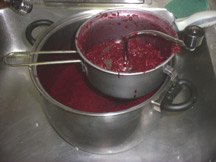
Are you trying to choose the right variety of apple for your needs? There are many to choose from. There are heirloom varieties that have been around for hundreds of years and apple growers are constantly creating new varieties to meet consumer tastes and 2025 is no exception. Scroll down this page for a table of dozens of apple varieties includingphotos and their characteristics and best uses. This page has tips about harvesting and storing apples. And if you bring home some apples and want to make applesauce, apple butter,apple juice, apple pie, apple cobbler, apple crisp, even apple cider, just click the links for each to follow directions and recipes or see this page see this page for a master list of simple, reliable, illustrated canning, freezing or preserving directions. There are plenty of other related resources, such as this list of local regional and apple festivals - click on the resources dropdown above.
If you have questions or feedback, please let me know!
What's in season in August 2025, and other timely information:
Notes for August 2025: Spring is here! Strawberry season is here. It started in February in Florida, Texas, southern California and a few other areas of the Deep South; then March along the Gulf coast, April in the Deep South and west coast, May through much of the country, and June in northern areas. Blueberries are next, about a month later. Of course, cool weather crops, like Rhubarb, asparagus and greens should be available almost everywhere. Check your area's crop calendar (see this page) and call your local farms for seasonal updates.
You may also be interested in finding a local:
- Children's Consignment Sale happening now; save money on children's clothes, toys, books, etc, find a local children's consignment sale, also often held by churches in the Spring and Fall, click here!
- Fun factory tours - usually free, fun and educational, find them in every state here!
- Road trip or a Camping trip - Find free and low-cost, but fun, interesting places to visit and things to do and see!
Are carpenter bees boring holes into your house, shed or barn? There is a simple non-toxic solution!
NEW! Start your own tomato, pepper, squash and other vegetable plants from seed - It's easy and
costs about 50 cents per plant.
Also see our Master list of tomato varieties,
with descriptions, details and links to ordering the seeds.
We also have home canning, preserving, drying and freezing directions. You can access recipes and other resources from the drop down menus at the top of the page or the site search. If you have any questions or suggestions, feel free to write me! It is easy to make your own ice cream, even gelato, or low fat or low sugar ice cream - see this page. Also note, there are many copycat website listing U-pick farms now. They have all copied their information from here and usually do not ever update. Since 2002, I've been updating the information every day but Christmas; so if you see anything wrong or outdated, please write me!
Apple varieties Alphabetical Chart - which apple to pick and why!
Apples are developing great his year. There have been no late frosts in the main apple growing regions, rain and temperatures have been good, so the year is shaping up well for a good apple crop. It's too early for prices, but I expect most areas to see $30 to $50 a bushel, depending on variety! Scroll down the page to see the chart, or click here for a PDF print version. And for an explanation of why apple slices turn brown and how to stop it, see this page! To see how to properly store apples for the winter, see this page!
Varieties which are exceptional for a trait are noted in the chart below (Best, very good, etc.). Varieties which are at least good and well-suited have an "X" in a column. A blank box simply means that they are average for the quality. Ultimately, it is personal preference and cultural traditions. that often determines which varieties of apples are used for which purpose. That said, sweeter and softer apples make the best applesauce (like Gala), harder, drier apples are often used for baking and storing (like Rome and Arkansas Black), and tarter, more crisp and juicier apples are often eaten fresh (like Honeycrisp).
The U.S. Apple Organization tells us the most popular (by sales) fresh apple varieties are, in order:
- Gala
- Red Delicious
- Fuji
- Granny Smith
- Honeycrisp
- Golden Delicious
- McIntosh
- Pink Lady
- Braeburn
- Ambrosia
Honeycrisp and Pink Lady continue to move up the chart, and Red Delicious is moving down. More heirloom varieties are being grown as specialty crops, and of course, every year sees some new varieties, most notably, those that resist browning when cut, like Ginger Gold, Ambrosia, Envy and SnowSweet.
Apple Varieties Guide - Which Apple to Pick and Why!
If you would like to print a clean PDF version of this table, click here.
Summary Table (click here for the detailed guide)
(Sorted alphabetically on variety name; see this page for a sort by typical ripening date)
Blank means OK or average. Note: all apples should be stored in the fridge; those noted below as needing refrigeration are exceptionally quick to spoil in not refrigerated.
|
Name |
Typical Ripening Date |
Eating fresh |
Cooking |
Notes and Storage Tips |
||||
|
|
August |
|
X |
|
|
|
|
|
|
|
mid to late |
X | X | good | X | X | X | Should Refrigerate. Does not brown when sliced (see this page for more info) |
|
|
mid to late October |
|
Baking | too hard |
|
|
|
Great keeper |
|
|
late September into October | X | X |
|
||||
 Autumn crisp Autumn crisp |
October | X | X | good | X | X | X | Cross of Golden Delicious and Monroe. Flesh resists browning |
|
|
late mid-season | X | X | X |
|
|||
|
|
early July | X | ||||||
|
|
mid to late October |
X | X | X | X | X | X | |
 Blondee Blondee |
October | X | X |
Very good |
X | X | X | Yellow skin with slight russeting at the stem and scattered tan-colored pores. It has a unique sweet-tart flavor, with a crisp & juicy white flesh. Excellent for eating fresh and for cooking in your favorite recipe |
|
|
early to Mid October |
X | X |
|
X | X | X | |
|
|
early to Mid October |
X | X | X | X |
|
|
Good all-purpose apple |
|
|
early to Mid October |
Very good |
X |
Very good |
X |
|
X | Excellent flavor, Does not brown when sliced (see this page for more info) |
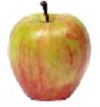 CandyCrisp CandyCrisp |
Early October (South), November (North) | X | X | good | X | X | X | |
|
|
mid to late September |
X |
|
X | X | X | X | Does not brown when sliced (see this page for more info) |
 Cosmic Crisp Cosmic Crisp |
mid to late September |
X | X | Excellent | X | X | X |
Cosmic Crisp is a cross between Honeycrisp and Enterprise apples, Storage is very good, High in both sugar and acidity, making it as good overall or better than Red Delicious, Gala and Fuji |
|
|
early season (August) |
X | X | good | ||||
|
|
mid to Late Season (September) | |||||||
|
|
Mid - late season |
Very good |
X | good, but watery | X | BEST | X | |
 Davey Davey |
mid to Late Season (September) | X | good, but watery | X | X | X | This is a McIntosh-type apple, sweet-tart, very juicy and crunchy. It is a better keeper than the McIntosh. | |
 Detroit Red Detroit Red |
early, August into September | X | X | Heirloom brought from France by settlers in the Detroit area, but then later planted by Thomas Jefferson, using grafted trees of Detroit Red in the nursery at Monticello in 1805. | ||||
|
|
August | X | X | X | X |
|
|
Must Refrigerate |
|
|
mid-August through September | X | X | X | X |
A McIntosh type apple with a long shelf life. Aromatic and crisp with creamy white juicy flesh, sweet and tart. Does not brown when sliced (see this page for more info) |
||
|
|
early to Mid October |
X | X |
|
|
|
|
|
 Envy Envy |
September | X | X | Very good | X | X | X | Envy apples are closely-related to Jazz, both are crosses between Gala and Braeburn, a trademarked variety of the Scilate apple. This is a new variety known for their crisp texture, sweetness, and balanced flavor. They are slightly larger than most apples, with a round shape, red skin and creamy yellow flesh. In 2024, they are grown in Washington state, New Zealand, and Chile. |
 Evercrisp Evercrisp |
Mid October through November |
Very good |
X |
Very Good |
X | BEST | X | Excellent storage due to it's parents (Fuji and Honeycrisp) |
|
|
mid to late October |
Very good |
X | BEST | X |
|
X | Excellent all purpose apple, with sweet aromatic flavor, Great keeper; stores well in garage or basement |
|
|
mid August to early September |
Very good |
X | BEST | X | X | X | Very sweet, excellent flavor, Must refrigerate; even then only keeps for a few weeks. Does not brown when sliced (see this page for more info) |
|
|
August |
Very good |
X |
Very good |
X |
|
X | Does not brown when sliced (see this page for more info) |
|
|
mid to late September |
X | X |
Very good |
X | X | X | Very sweet, mild flavor, Should Refrigerate |
|
|
mid to late September |
X | X |
Very good |
X | X | X | Tart, strong aroma flavor, should Refrigerate. Does not brown when sliced (see this page for more info) |
|
|
mid to late October |
X | X |
|
|
X |
|
Very tart almost sour apple |
 Gravenstein Gravenstein |
August | X | X |
Very good |
X | X | X | Should Refrigerate |
 Grimes
Golden Grimes
Golden |
August | X | X | X | ||||
|
|
late mid-season (late September) |
Very good |
X | BEST | X |
|
X | Excellent all purpose apple, with sweet aromatic flavor, good keeper; |
|
|
September |
Very good |
X | good, but watery | X | BEST | X | Sweet, crisp apple. Storage is good, not great |
 Idared Idared |
October | X | X |
|
X |
|
|
|
|
|
early to Mid October |
X | X |
Very good |
X | X | X | Newer variety, sweet, juicy |
|
|
August | X | X |
|
|
|
|
OK |
|
|
mid to late September |
X |
|
Very good |
|
X |
|
OK storage, great all purpose apple. |
|
|
mid to late September |
X | X |
Very good |
X | X | X | Must Refrigerate, very sweet. |
 Jonamac
Jonamac |
mid to late September |
X |
|
Very good |
|
X |
|
OK |
|
|
mid to late September |
X | X |
Very good |
X | X | X | OK |
|
|
mid September |
X | X | X | X |
|
|
Stores well - it is an earlier version of Fuji |
|
|
Late September to
early October |
X | X |
|
X |
|
|
|
|
|
mid to late October |
X | X |
|
|
|
|
|
|
|
Mid July | X |
|
GOOD |
|
|
|
Must Refrigerate
|
|
|
mid to late October |
X | X |
|
|
|
|
|
|
|
September | X |
|
good |
|
X | X | |
|
|
early to Mid October |
X | X |
Very good |
X | X | X | |
|
|
August |
|
X |
|
|
|
|
Must Refrigerate |
|
|
Late September to
early October |
X | X |
Very good |
X |
|
X | |
|
|
Late September to
early October |
X | X |
|
|
|
|
Very good for storing |
|
|
mid to late October |
X | X |
|
|
X |
|
Does not brown when sliced (see
this page for more info) |
 Ozark Gold Ozark Gold
|
Early August | X | ||||||
|
|
mid August to early September |
X | X | X | X |
|
X | |
|
|
mid to late October |
X | X | good | X | X | X | |
 Pink Pearl Pink Pearl |
Mid- August | X | X | good | Tart but sweet. Firm. | |||
 Pristine Pristine |
early July | X | X | good | Very sweet, juicy, does not store well, bruises easily (like Gala) | |||
|
|
mid to late September |
X |
|
good |
|
|
X | |
 Redfree Redfree
|
Late-July | X | X | Firm flesh and can be held in storage up to 2 months without loss of quality or firmness. | ||||
|
|
early to Mid October |
|
X |
|
X |
|
|
|
|
|
Late season, ripens later in the fall | X |
|
|||||
|
|
X |
|
Not a great keeper | |||||
 September Wonder September Wonder |
mid-September | X | X | X | Sweet older variety, dates back to Washington State, 1902 | |||
|
|
Late September to
early October |
X | X | X | X | X | X | Does not brown when sliced (see this page for more info) |
 Snowsweet Snowsweet |
Late September, 2 weeks after HoneyCrisp | X |
|
X | X | X | X | Good storer. Does not brown when sliced (see this page for more info) |
|
|
Early September | X |
|
|
|
|
|
|
|
|
mid to late October |
X | X | good |
|
X |
|
|
 Strawberry Strawberry |
Early September | X | X | X | X | X | X | OK for storage. Also called the Chenango Strawberry apple |
 Summer banana Summer banana |
mid-August | X | X | heirloom, when fully ripe has the faint smell of bananas | ||||
|
|
mid to late October |
X | X |
|
X | X | X | |
|
|
early to Mid October |
X | X |
|
|
X | X | |
|
|
mid August to early September |
X |
|
X | X |
|
X | |
|
|
mid to late September |
X | X | X | X | X | X | |
 Virginia Gold Virginia Gold |
Late-September | X | X | Also good for apple cider | ||||
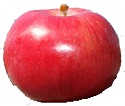 Vista Belle Vista Belle |
July | X | X | X | X | X | X |
Crisp, tart and remarkably rich-flavored apple, does NOT store well |
 Wild Crisp Wild Crisp |
October |
Very good |
X | good, but watery | X | BEST | X | Cross between Honeycrisp and Cripps Pink (AKA Pink Lady)Juicy, sweet, crisp, great for fresh eating or all-purpose, applesauce or in a fruit salad |
 William's Pride William's Pride
|
Early-July | X | X | |||||
|
|
late-season | X | All-purpose apple | |||||
|
|
mid to late October |
X | X |
|
X | X |
|
Stores very well |
|
|
X | X | ||||||
 Zestar Zestar |
mid-July to mid-August | X | X | X | X | X | X | Should Refrigerate |
Click here for detailed descriptions of each apple variety with detailed characteristics
Of course, each region of the country and each season varies. Variations in rainfall and temperature greatly affect the usual ripening date. So call ahead!
English Apple Varieties
These links take you to photos on GardenAction.co.uk
- Bramley - The English gush over this apple with a fever (fevour?:) that borders on mania. It's basically a granny smith type, a higher acid content and lower sugar apple, with a stronger, more tangy taste. Bramley's are considered to be an ideal cooking apple.
- Charles Ross
- Crispin
- Early Victoria
- Early Worcester
- Ellisons Orange
- Epicure
- Gibsons Scarlet
- Golden Spire
- Greensleaves
- Howgate Wonder
- Ingrid Marie
- James Grieve
- Jonagored
- Jupiter
- Katy
- Orleans Reinette
- Peasgood Nonsuch
- Red Gravenstein
- Red Victoria
- Rev W. Wilks
- Ribston Pippin
- Rosemary Russett
- Spartan
- Sturmer Pippin
- Sunset
- Superb
- Tydermans Late Orange
- Warners King
- Winston
More about apple varieties can be found:
University of Illinois Apple page
Apple photos and brief descriptions
Credits:
photos:
Jonamac, Macoun, PaulaRed: Courtesy of New York Apple Association, © New York
Apple Association
And if you are looking for shipping containers for apples and other fruit, see this page.
Canning Books, Supplies and Accessories
These are my favorite essential canning tools, books and supplies. I've been using many of these for over 50 years of canning! The ones below on this page are just the sampling of. my preferred tools. but you can find much more detailed and extensive selections on the pages that are linked below.
- Strainers, pit removers, seed-skin-stem removers, jelly strainers, etc. All types, makes and prices (from $19 to $350)
- Selecting a KitchenAid mixer and attachments for home canning
- Vacuum Foodsealers for freezing, dried foods, and refrigerated foods - the FoodSaver line
- Cherry pitters reviews, prices and ordering
- Steam Juicers
- Food dehydrators - easy and fast to dry your own fruits, veggies, sun-dried tomatoes, etc.
The All New Ball Book Of Canning And Preserving: Over 350 of the Best Canned, Jammed, Pickled, and Preserved Recipes Paperback
This is THE book on canning! My grandmother used this book when I was a child.; It tells you in simple instructions how to can almost anything; complete with recipes for jam, jellies, pickles, sauces, canning vegetables, meats, etc.
If it can be canned, this book likely tells you how! Click on the link below for more information and / or to buy (no obligation to buy)The New Ball Blue Book of Canning and Preserving
Canning and Preserving for Dummies by Karen Ward
This is another popular canning book. Click here for more information, reviews, prices for Canning and Preserving For Dummies
Of course, you do not need to buy ANY canning book as I have about 500 canning, freezing, dehydrating and more recipes all online for free, just see Easy Home Canning Directions.
Home Canning Kits
See here for related tools, equipment, supplies on Amazon See here for related tools, equipment, supplies on Amazon
I have several canners, and my favorite is the stainless steel one at right. It is easy to clean and seems like it will last forever. Mine is 10 years old and looks like new.
The black ones are the same type of standard canner that my grandmother used to make everything from applesauce to jams and jellies to tomato and spaghetti sauce.
This complete kit includes everything you need and lasts for years: the canner, jar rack, Jar grabber tongs, lid lifting wand, a plastic funnel, labels, bubble freer, It's much cheaper than buying the items separately. It's only missing the bible of canning, the Ball Blue Book.
You will never need anything else except jars & lids (and the jars are reusable)!
The complete list of canners is on these pages:
- Water bath canners - Good for acidic foods, like applesauce, pickles, salsa, jams, jellies, most fruits
- Pressure canners - needed for low and non-acidic foods, like canned vegetables (corn, green beans, etc), and meats
- Canners for glass top stoves if you have a glass or ceramic stove
- Canners for induction stovetops
Pressure Canners
If you plan on canning non-acidic foods and low acid foods that are not pickled - this means: meats, seafood, soups, green beans corn, most vegetables, etc., then you ABSOLUTELY must use a Pressure Canner.
Of course, you can use a pressure canner as a water bath canner as well - just don't seal it up, so it does not pressurize. This means a Pressure Canner is a 2-in-1 device. With it, you can can almost ANYTHING.
There are also other supplies, accessories, tools and more canners, of different styles, makes and prices, click here!
Basic Canning Accessories
From left to right:
- Jar lifting tongs to pick up hot jars
- Lid lifter - to remove lids from the pot of boiling water (sterilizing )
- Lids- disposable - you may only use them once
- Ring - holds the lids on the jar until after the jars cool - then you remove them, save them and reuse them
- Canning Jar funnel - to fill the jars
Strainers
These are very useful for making sauces like applesauce, tomato sauce, spaghetti sauce, jellies, etc. Below are my favorites. The complete list is on these pages:
- Strainers, pit removers, seed-skin-stem removers, jelly strainers, etc. All types, makes and prices (from $19 to $350)
- Selecting a KitchenAid mixer and attachments for home canning
Inexpensive Old School Strainers: hand cranked Foley Food Mills
- The hand-cranked Foley food mill (see this page or clock the ad box) has been used for well over 100 years in homes all over America (and variants around the world). It is effective and inexpensive, and ideal for small batches. However, if you need to make many quarts, you will sure end up with tunnel carpel syndrome or some other repetitive strain injury.
Norpro 1951 Manual Food Strainer and other brand stariners, with optional motors; (almost identical to Victorio V250, Villaware and Roma models, all discontinued)
This is The next step up from the Foley food mill. First, it's far more ergonomic, and its handle is easier to use. Next, it works in continuous mode rather than batch mode. So you can do much larger volumes easily. Finally, It has an optional motor, so you can. remove the manual labor. It also offers many different size strainers to use for different types of berries, vegetables and fruit.
See the seller's website for more information, features, pricing and user reviews!
- A Johnny, Weston or Oxo strainer (about $60 - $100, see further down the page) or
- This trainer is. simply a more upscale and improved version of the one above.
- See this page for more information, reviews, descriptions of other strainers and supplies or to order!
KitchenAid - Best Large Volume Strainers
If you're going to do large volumes of fruit or vegetables , or do it year after year, then. you really should think about getting a higher end kitchen. utility device. Kitchen aids are the cream of the crop. Once you buy one of these, you keep at the rest of your life and it gets handed down to the next generation. . My sister is using one she inherited from my mother 25 years ago, who got it in the 1940s as a wedding gift. So, although the initial cost is high, they literally last for many lifetime. So the cost on an annual basis is pretty trivial, especially when you consider the cost of therapy and treatment for. the repetitive strain injuries you will get from manual cranking day after day. Add to that of course the cost of therapy for the emotional injuries you'll get from going insane, standing there hand cranking something for hours.
KitchenAid's with a sieve/grinder (with the attachments, costs about $400, but it lasts a lifetime and is fast and easy to use - I can make 100 quart jars of applesauce per day with one of these).
FREE Illustrated Canning, Freezing, Jam Instructions and Recipes
Don't spend money on books. that you don't need to. Almost everything you can find in some book sold online or in a store is on my website here for free. Start with theEasy Home Canning Directions below. That is a master list of canning directions which are all based upon the Ball Bblue book, the National Center for Home Food Preservation and other reputable lab tested recipes. Almost every recipe I present in addition to being lab tested com. is in a step by step format with photos for each step and complete. explanations. that tell you how to do it, where to get the supplies and pretty much everything you need to know. In addition, there almost always in a PDF format so you can print them out and use them while you cook.
[ Easy Home Canning Directions]
[FAQs - Answers to common questions and problems]
[Recommended books about home canning, jam making, drying and preserving!]
Looking for canning equipment and supplies?
Water bath canner with a jar rack
Pressure canners for gas, electric and induction stoves: Presto 23Qt or T-fal 22Qt
Canning scoop (this one is PERFECT)
Ball Blue book (most recent version)
Jars: 8oz canning jars for jams
Find Other types of farms:
Farm markets and roadside stands
Road trips and camping resources
Local Honey, apiaries, beekeepers
Consumer fraud and scams information
Home canning supplies at the best prices on the internet!
Maple Syrup Farms, sugarworks, maple syrup festivals
Environmental information and resources
Farms For Your Event for birthday parties, weddings, receptions, business meetings, retreats, etc.
Festivals - local fruit and vegetable festivals
Get the
most recent version of
the Ball Blue Book
With this Presto 23 quart pressure canner and pressure cooker, you can "can" everything, fruits, vegetables, jams, jellies, salsa, applesauce, pickles, even meats, soups, stews. Model 01781

You can make jams, jellies, can fruit, applesauce, salsa and pickles with water bath canners, like this Granite Ware 12-Piece Canner Kit, Jar Rack, Blancher, Colander and 5 piece Canning Tool Set

 Akane
Akane
 Ambrosia
Ambrosia
 Arkansas Black
Arkansas Black
 Ashmead
Kernal
Ashmead
Kernal


 Black Twig
Black Twig
 Blushing Golden
Blushing Golden
 Braeburn
Braeburn
 Cameo
Cameo
 Cortland
Cortland
 Cox's
Orange Pippin
Cox's
Orange Pippin
 Crimson Crisp
Crimson Crisp
 Crispin (aka, /Mutsu)
Crispin (aka, /Mutsu)
 Earligold
Earligold
 Empire
Empire Enterprise
Enterprise
 Fuji
Fuji
 Gala
Gala
 Ginger Gold
Ginger Gold
 Golden Delicious
Golden Delicious
 Granny Smith
Granny Smith
 Hokuto
Hokuto
 Honeycrisp
Honeycrisp

 Jersey
Mac
Jersey
Mac
 Jonagold
Jonagold
 Jonathan
Jonathan
 Jubilee
Jubilee
 Keepsake
Keepsake
 Liberty
Liberty
 Lodi
Lodi
 Macoun
Macoun
 McIntosh
McIntosh
 Melrose
Melrose
 Mollies Delicious
Mollies Delicious
 Mutsu,
also called Crispin
Mutsu,
also called Crispin
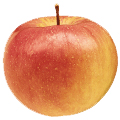 Northern
Spy
Northern
Spy
 Opal
Opal
 PaulaRed
PaulaRed
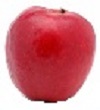 Pink
Lady
Pink
Lady
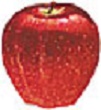 Red
Delicious
Red
Delicious
 Rome
Rome
 RubyFrost
RubyFrost
 Sansa
Sansa
 Shizuka
Shizuka
 Stayman
Stayman
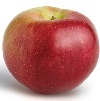 Stayman
Winesap
Stayman
Winesap
 Suncrisp
Suncrisp
 Sundance
Sundance
 SweeTango
SweeTango
 Ultra Gold
Ultra Gold
 Winesap
Winesap
 Yates
Yates
 York
York

